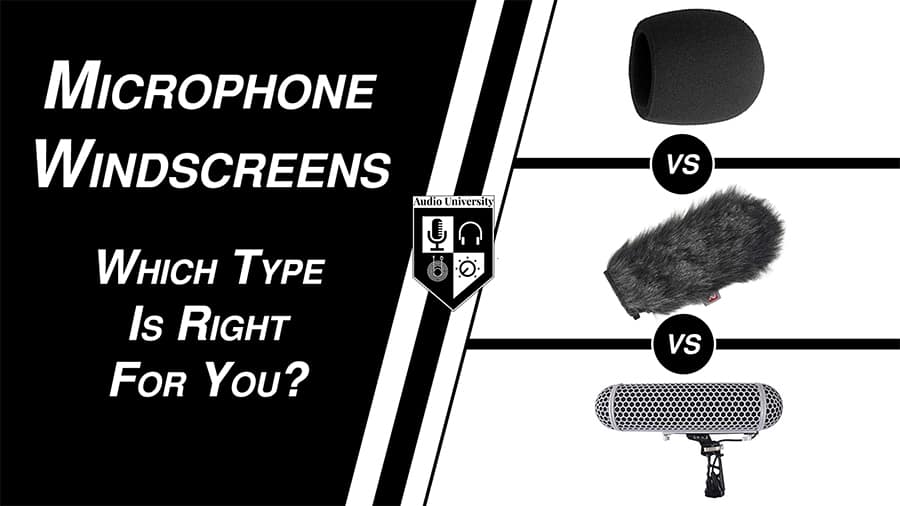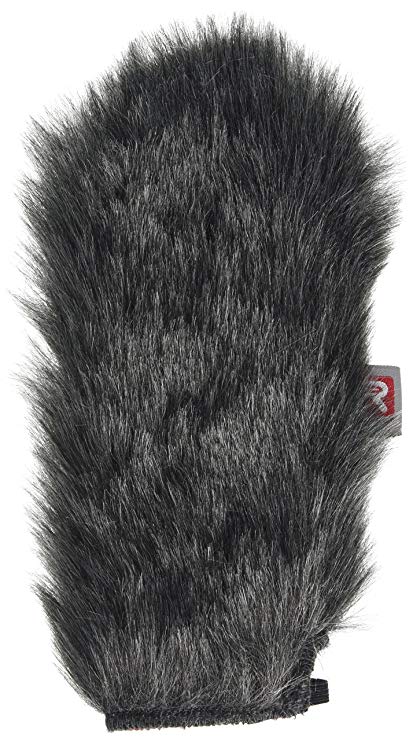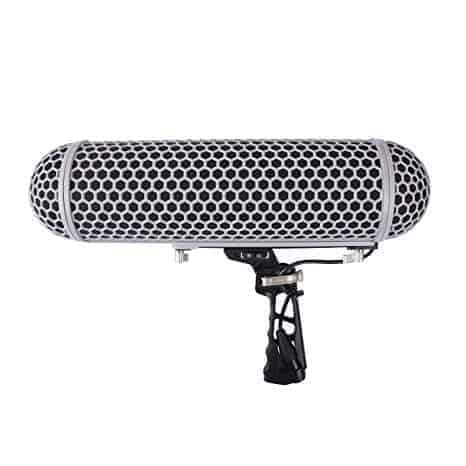
Have you ever tried to record audio outdoors on a windy day? Have you ever recorded someone who speaks too close to the microphone? In both cases, microphone pops from gusts of air are inevitable without the proper equipment. This post is all about the most important tool for these scenarios: windscreens.
The foam or fur cover of a microphone is called a windscreen. A windscreen protects the microphone diaphragm from gusts of air. Without a windscreen, wind or breathing can cause loud pops in the audio signal. Windscreens break up gusts of air before they interact with the microphone diaphragm.
In this article, you’ll learn about the various types of windscreens, when to use them, and how to make your own in an emergency situation.
The foam or fur cover of a microphone is called a windscreen. A windscreen protects the microphone diaphragm from gusts of air.
When to Use a Windscreen
There are some obvious reasons to use a windscreen and some not-so-obvious reasons. This section will explore the uses of windscreens.
Outdoor Recording
Whether it be for a concert, a film shoot, or an interview, recording outside presents unpredictable circumstances. Weather can change at short notice and it’s important to have the proper tools to overcome the obstacles that the outdoors may present. A windscreen is an essential part of this toolkit.
Have you ever listened to a video recorded outdoors? Often, the soundtrack of an outdoor video contains the distracting sound of wind. This noise is a low- to-mid-frequency sound that sometimes makes it difficult to hear the words being spoken.
Hopefully, you haven’t yet fallen victim to this problem as a sound recordist. If you have, you know that removing this noise without destroying the sound quality of your recording is nearly impossible. It’s best to prevent the noise from the beginning, through the use of a windscreen. A windscreen will redirect the wind away from the microphone diaphragm, while allowing sound waves to pass.
Recording Indoors Near HVAC Systems
Even indoors, wind can be an issue. Heating and air conditioning systems can create air currents. Fans can also cause indoor wind.
If you are recording indoors, be sure not to place the microphone near any source of forced air. However, if you are installing a system that will be used throughout the day without supervision, such as a conference room or public address system, you will have no control. Users may choose to use a fan in the room, not knowing the issues it might create. You can use a windscreen as an insurance plan for unexpected drafts that might occur indoors.
Recording with a Moving Microphone
Keep in mind that wind moving past a stationary microphone is no different from a microphone moving through stationary air. If the microphone will be moved while in use, use a windscreen.
If you are using a boom pole for a film shoot, you might need to move the microphone to capture a moving source or multiple sources. You may be recording a scene in a vehicle or from a vehicle. In any case, windscreens can help protect the microphone from the air resistance created while in motion.
Recording a Vocalist
Most speak too far away from the microphone, but some speak far too close to the microphone. A recording of a person speaking too closely to the mic will likely contain loud “p-pops”. Prevent these pops by using a windscreen.
Any time someone speaks a plosive sound, such as “b”, “d”, “g”, “k”, “p”, or “t”, a sudden release of air is created. This image shows the waveform of a microphone pop created by a plosive.

The best way to address popping in a microphone is through the use of a pop filter. A pop filter is a mesh or wire screen placed between the microphone and the person speaking. Pop filters diffuse the air created by plosive sounds that would normally directly hit the microphone diaphragm.
If you are trying to prevent the p-pops caused by plosive sounds, you may want a pop filter instead of a windscreen. Check out this other article I wrote about the best pop filters for any budget.
Although pop filters are the best method, it’s not always possible to use them. Windscreens can be used in these situations, although they are less effective.
Protecting a Microphone
Although the primary function of windscreens is to prevent wind noise, they are also somewhat effective in protecting microphones. Aside from the fact that excessive wind can cause damage to a microphone’s membrane, other risks exist.
Inside the grill of a Shure SM58, you’ll find a foam liner. This acts as a windscreen to prevent noise from bursts of air and as a screen to protect the capsule from saliva and dirt. When the microphone inevitably becomes dirty from years of use, simply replacing the windscreen will restore the microphone to a like-new state.

Types of Windscreens for Microphones
All windscreens aim to prevent the low frequency vibrations caused by gusts of air. However, despite the fact that they share the same goal, all windscreens are not created equally.
In this section, you’ll learn the primary differences between them.
Foam Windscreens
Most windscreens are made of open-cell foam.
Many microphones include a specially-made windscreen in the box. You can also purchase a universal windscreen to fit various sizes of microphones. Foam windscreens fit snugly around a microphone and provide basic protection from wind.
I recommend this one on Amazon. It is a common size, which means it will fit a variety of microphones. Plus, it’s so inexpensive that you can easily buy a few so you’re always prepared for unexpected wind.
The cells of the foam create a labyrinth effect for the wind, diverting it in various directions and preventing the wind from directly interacting with the microphone.

Foam windscreens generally offer up to about 8dB of wind noise attenuation, or reduction. Although this is significant, you will see that other types of windscreens are much more effective. Despite the fact that foam windscreens remove a significant amount of wind noise, they do not cause significant high-frequency loss.
Additionally, as opposed to other types of windscreens, foam windscreens are fairly neutral aesthetically, so they are more acceptable as microphones on video.
Synthetic Fur Windguards or Windjammers
Windguards, or windjammers, are a more effective type of windscreen. These consist of two layers: an inner layer of thin foam and an outer layer of synthetic fur.
They are available in various sizes to slip on over a variety of microphones. Windjammers offer superior wind protection, compared to foam windscreens.
The strands of fur act as baffling to redirect wind. This method creates less friction than stiff foam, which means less noise is created in the process.
Windjammers are most often designed to fit specific microphones, but you can find models like this windjammer that will fit a variety of shotgun mics.

Fur windguards offer between 25dB-40dB of wind noise attenuation. Layering a windjammer over a windscreen can offer up to 50dB of attenuation. They are drastically more effective than foam windscreens, alone. However, it’s important to consider the quality. Low-quality fur windscreens can cause high-frequency attenuation. High-quality windjammers effectively reduce wind noise, while creating virtually no adverse effects on sound quality.
Aesthetically, these may not be the best option for on-video microphones. They are lovingly referred to as “dead cats”.
Baskets or Blimps
Baskets, or blimps, are the best option for max noise protection. These also consist of two layers: an inner layer of thin foam and an outer layer of plastic or metal mesh.
Baskets are available in a variety of sizes. Many options allow multiple microphones to be housed inside. In addition to wind protection, baskets offer shock absorption by suspending the microphone, or microphones.
This added protection a blimp-style windscreen offers from wind and vibration comes at a price, but may be worth it if you are working professionally.
This method of suspension creates a large chamber of dead air which lends itself to maximum attenuation up to 50dB with minimal high-frequency loss.

Choosing a Windscreen
There are a few things to consider when buying a windscreen. It comes down to the specific gear you’ll be using with the windscreen and the purpose of using it. This section will walk you through the most important factors.
Microphone Type and Size
Windscreens are available in a vast range of sizes and styles. It’s important to choose one that fits snuggly on your microphone to seal any leakage points and prevent air from disturbing the diaphragm.
Most handheld microphones can be protected using universal foam windscreens. Just make sure that any ports on the grill are fully covered by the screen when choosing one. You can likely find a universal option for use on both large and small diaphragm condenser microphones and lavalier (or clip-on) microphones, as well. Follow the same guidelines.
Special windscreens are made that cover the long barrel of a shotgun microphone. Be sure to choose one that is large enough without allowing too much wiggle room. If the windscreen shifts, it will create noise.
Noise Attenuation
Attenuation, or noise reduction, is the most important factor. You can read the section above that shows the vast differences in the effectiveness of the various types of windscreens. Choose this based on how you will be using the microphone.
If you are using a shotgun microphone, you will likely be several feet away from the sound source, and thus will need more gain. Additionally, directional microphones are especially susceptible to wind noise. For these reasons, opt for a fur windjammer or a basket when using a shotgun mic. These will offer significantly more protection and ensure that a whole film shoot isn’t ruined by poor audio.
Acoustic Transparency
There is a trade-off between noise attenuation and high frequency loss. Generally speaking, acoustic transparency will decrease with the addition of more layers. The highest quality options do a great job of blocking the wind without adversely affecting audio quality. In most situations, you can boost the high frequencies in post to restore any loss that occurred during the recording.
Weight
If you will be holding a shotgun microphone on a boom pole for hours, you will want to keep weight in mind when selecting a windscreen. The microphone alone can be heavy enough. Be sure not to add any unnecessary weight.
How to Make Your Own Windscreen
In 1969, The Beatles played a surprise concert on the rooftop of Apple Records. The setting of this concert introduced a lot of obstacles for Glyn Johns and Alan Parsons, two of the audio engineers working on the project. One of these obstacles was wind. Mike Dow offers us a look into one of the improvisational tricks used by these engineers to overcome this obstacle in his article, “Alan Parsons remembers Beatles producer George Martin” from The Main Edge (2016):

“In 1969, on a blustery Jan. 30, Parsons then age 19 – was one of the few permitted access to The Beatles’ surprise lunchtime live performance from the group’s Apple building rooftop, as cameras rolled in hopes of capturing a suitable ending for the film that became ‘Let It Be.’ It was a gig that Parsons says he stayed up all night preparing for. After running cables from the roof to the basement studio where engineer Glyn Johns was recording the performance, Parsons was sent to purchase pairs of pantyhose (‘we called them tights,” he laughs) to act as a windscreen for the microphones.”
There you have it. There are many products on the market to overcome wind noise for a variety of applications. Any professional audio engineering toolkit will include tools for the unexpected. When you are caught off-guard, however, think quickly and creatively to solve the problems at hand.
